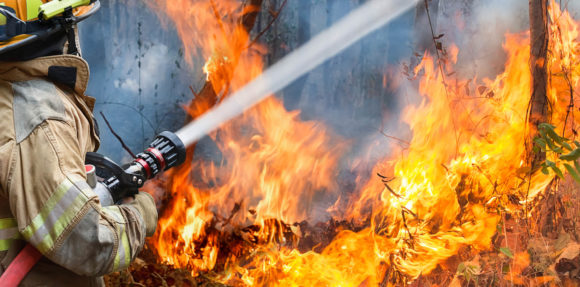Original article can be found HERE.

The U.S. has in store an “above-normal” wildfire season if a prediction out on Wednesday from fire weather experts holds true – “intense” may be a better word for the expectations in Western region.
Early predictions for the 2022 fire season point to 68,000 to 72,000 fires across the nation burning 8.1 to 8.3 million acres. The national average from 2001 to 2020 was 68,707 fires burning 7 million acres, according to the National Interagency Fire Center.
This year has already been notable by historical wildfire season standards. Wildfires have burned more than 1.1 million acres, twice the number by this date in 2021, according to AccuWeather fire forecasters.
Another severe wildfire season in the Western U.S. seems likely based on the analysis from AccuWeather forecasters, who say the West is undergoing an “aridification,” a gradual drying out, from the ongoing multi-decadal drought, while the impacts from climate change are expected continue to heighten the wildfire threat in years to come.
The “mega-drought” throughout the Southwestern U.S. is considered the region’s worst in 1,200 years, according to a study in the journal Nature Climate Change, which forecasts the mega-drought is likely to persist through 2022, matching the duration of the a late-1500s mega-drought.
Through the end of April, most of the West was in at least a “moderate drought,” with 79% of the region experiencing at least “severe drought,” and nearly 37% in extreme or exceptional drought, according to the U.S. Drought Monitor.
Below-average winter and spring precipitation totals across the West have set the stage for a higher-than average wildfire risk this season, according to the forecast from AccuWeather meteorologists, who forecast the drought could “spur another intense season” for the region.
“The long-term drought in the West sets the stage for another serious wildfire risk this season,” said Johnathan Porter, AccuWeather’s chief meteorologist.
The analysis doesn’t break up 2022’s expected figures of 8.1 to 8.3 million acres burned into how much each region will contribute, however, “the West is a predominant, huge driver of that,” Porter said.
California mountain areas were gifted with a heavy dose of moisture in April, increasing snowpack, but that doesn’t appear to be enough to mitigate what has been a drier-than-normal wet season for the state, according to the analysis.
“The fundamentals once again look like the set-up is a very serious one, and one that will result in an above-average season,” Porter said.
AccuWeather’s long-range team compared past years with similar atmospheric and ocean conditions going on this year, along examining indications for coming months, as well as the persistent drought, to get a forecast for the nation’s fire season.
The team’s forecast across other regions is:
- Pacific Northwest: Call it a “mixed bag.” The region has experienced an active storm trek the last few months yielding near- or above-normal precipitation, reducing drought conditions. The expectations are for the fire season to start slow, with some rainfall into June, and most of the risk in late July or August.
- Southwest: Forecasters expect a boosted monsoon season to help mitigate some of the risk during the most severe part of the season in July. This may result in a lower-than-average risk of wildfires.
- Southeast: There is concern for an elevated chance for fires in the region, especially across south Florida where it has been unusually dry, through May and into June, when tropical storms and more frequent moisture are expected to reduce risk. In parts of the Carolinas drought concerns may yield higher-than-average risk of fires. Texas is expected to be warmer than normal, with significant fire concerns though the summer months.
- Northeast: No big concerns for this region. Forecasters are expecting above-normal precipitation across certain corridors from the June to August time-period. At present, there is increased risk for brush fires where it has been dry in some spots.
- Midwest: Drought in the panhandle and high plains and warmer-than-normal temperatures have produced elevated wildfire risk in the plains.
There are of course wildcards that could affect the forecast, particularly in volatile California, where lightning and wind have in the past impacted the frequency and severity of fires. One of best-known wind threats are Southern California’s Santa Ana winds, which typically peak between October and February.
And thunderstorms are of significant concern in the summer north of San Francisco Bay, and “should that occur, that will cert increase the risk for more widespread fires there,” Porter said.

